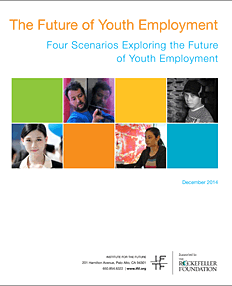Future Now
The IFTF Blog
Does online learning actually lead to jobs?
 In this blog post we’ll attempt to answer as many of these questions as we can:
In this blog post we’ll attempt to answer as many of these questions as we can:
What is the relationship between online learning platforms and finding a job?
How do MOOC platforms think about the relationship between learning and jobs?
Who takes online courseware, and why?
What are the aspects of MOOC platforms that make them more or less successful for finding work?
What is the future of this space?
If you’ve ever felt compelled to take an online course on Coursera, Udacity, or EdX, you’re not alone. Millions have. Although these platforms have only been around for a few years, there is no shortage of enthusiasm around their potential impact. As Anant Agarwal, CEO of EdX puts it, they have the potential to “unbundle education.”
Right now, universities and colleges are full stack- they have to deal with credentialing, infrastructure, staffing, recruitment—all on their own, meaning redundancy, as opposed to focusing on their core value add. It’s a compelling argument. There is no shortage of compelling arguments around why MOOCs matter. But, so far, nobody is addressing the biggest question of all.
Will MOOCs help you get a job?
After all, why do people go to University in the first place?
The relationship between education and jobs is the final frontier of online courseware. In the same audio interview cited earlier, Agarwal states that EdX has helped at least 100 people get a job. If that was the success rate of a college’s career guidance office, the college would no longer exist. Of course, MOOC platforms are not built to be education to job pipelines. They’re built to educate the world. Even though those are vast and valid ambitions, they’re actually easier than guiding people into careers.
Helping learners find jobs through completing online courseware requires new partnerships and greater widespread acceptance of the validity of near-free online learning credentials. Coursera has its Specializations, groupings of related courses that, when completed together, almost mimic a college degree in a subject area. Udacity has nanodegrees which they deem “credentials built and recognized by industry leaders to advance your career.” Among the larger MOOC platforms, Udacity leads among exploring industry partnerships. Its Open Education Alliance aims to use Udacity to bridge skill gaps created by inefficiencies in traditional higher education.
Of course, there is a mismatch between these ambitions and the current demographic of MOOC students. Both within the United States and globally, a 2013 survey identified that 80% of MOOC students already have a college degree, meaning the ‘education revolution’ targets the top 6% of learners anyway. These are the type of people who already have experience learning, and don’t need these platforms to get their first job. The same study showed that roughly half of all MOOC students take them “just for fun,” while 43.9% aim to use the course to do their existing job better.
The idea of online courseware revolutionizing meaningful access to education as a pathway to jobs is, for the most part, not yet true. Other new education institutions, like General Assembly tap into online learning as a part of the approach. General Assembly aims to train workers specifically to meet emerging skills gaps in technical fields. This focus on job placement, however, is naturally at odds with most large MOOC platforms.
Why MOOC platforms are at odds with job placement:
Large MOOC platforms are structurally designed to be difficult to aid with job placement.
First of all, they are inherently global. Although this means hypothetical access to the best, most ambitious student body, that also means no geographic base. Unless you are hiring for a remote workforce, partnering with a local university makes more sense than seeking applicants off of MOOCs.
Secondly, their economies of scale are actually a disadvantage. By democratizing access to education, MOOCs mean a potentially limitless student body by size, while employment opportunities are limited. In the best case scenario, you take the top 5% of students by performance and offer them access to interviews and applications. However, this can lead to cheating and trust issues with student performance.
Finally, in the same way the first TV broadcasts were simply Radio broadcasts with a TV camera, MOOC platforms are for the most part the university experience juxtaposed onto a new medium. Because of this, courses appeal most predominantly to people with existing higher education experience, and therefore the audience is double-counted.
In all fairness, this is a new technology, less than half a decade in the limelight. As these platforms naturally mature, they will differentiate and evolve to fill the ‘jobs’ challenge.
If MOOCs could design processes and training pipelines to target non-traditional learners, online courseware platforms could become much more impactful.
Interested in learning more?
- Find out about IFTF's Workable Futures Initiative
- Check out these other posts:
And follow us at @IFTF and look for more announcements about our Workable Futures Initiative soon.



